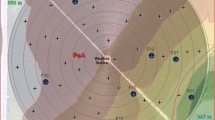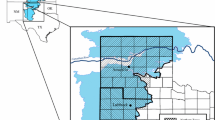Abstract
Engineering technologies for site-specific irrigation management (SSIM) have already been developed for applications in precision irrigation. However, further studies are needed to identify scenarios where SSIM leads to better agronomic outcomes than conventional uniform irrigation management (CUIM). The objective was to conduct a long-term simulation study to compare SSIM and CUIM given spatial soil variability at the Maricopa Agricultural Center (MAC) in Arizona. More than 500 surface soil samples were collected across a 730-ha area of the MAC from 1984 to 1987. A more detailed soil data set was more recently obtained across a 5.9-ha area at a MAC location designated for SSIM studies. Ordinary kriging was used for spatial interpolation of soil hydraulic properties within \(10\,\hbox {m} \times 10\,\hbox {m}\) zones across the MAC, and 11 field parcels with an area of approximately 60 ha were delineated on the MAC quarter sections. Using an agroecosystem model, simulations of cotton production at the zone level with a 30-year weather record were conducted using a field-tested algorithm to optimize irrigation schedules for SSIM and CUIM. Long-term seed cotton yield, irrigation requirements, water use efficiency, and marginal net return for SSIM and CUIM strategies were often not different (\(p>0.05\)). Differences in seed cotton yield and irrigation requirements among the tested irrigation strategies were less than 11% and 6%, respectively, and within the typical range of model error. Most soils on the MAC have enough available water holding capacity to sustain cotton production at full potential with weekly CUIM, and advantages of SSIM were not consistently demonstrated by the simulations.






Similar content being viewed by others
References
Al-Kufaishi SA, Blackmore BS, Sourell H (2006) The feasibility of using variable rate water application under a central pivot irrigation system. Irrig Drain Syst 20(2–3):317–327
Bronson KF, White JW, Conley MM, Hunsaker DJ, Thorp KR, French AN, Mackey BE, Holland KH (2017) Active optical sensors in irrigated durum wheat: nitrogen and water effects. Agron J 109(3):1060–1071
Cooper LR, Haverland RL, Hendricks DM, Knisel WG (1984) Microtrac particle-size analyzer: an alternative particle-size determination method for sediment and soils. Soil Sci 138(2):138–146
Daccache A, Knox JW, Weatherhead EK, Daneshkhah A, Hess TM (2015) Implementing precision irrigation in a humid climate: recent experiences and on-going challenges. Agric Water Manag 147:135–143
Day PR (1965) Particle fractionation and particle size analysis. Methods of Soil Analysis, American Society of Agronomy, Madison, Wisconsin, pp 545–556
DeJonge KC, Thorp KR (2017) Implementing standardized reference evapotranspiration and dual crop coefficient approach in the DSSAT Cropping System Model. Trans ASABE 60(6):1965–1981
Evans RG, King BA (2012) Site-specific sprinkler irrigation in a water-limited future. Trans ASABE 55(2):493–504
Evans RG, LaRue J, Stone KC, King BA (2013) Adoption of site-specific variable rate sprinkler irrigation systems. Irrig Sci 31(4):871–887
Gee GW, Bauder JW (1986) Partical-size analysis. In: Methods of soil analysis, Part 1. Physical and mineralogical methods, ASA-SSSA, chap 15, pp 383–411
Haberland JA, Colaizzi PD, Kostrzewski MA, Waller PM, Choi CY, Eaton EE, Barnes EM, Clarke TR (2010) AgIIS, agricultural irrigation imaging system. Appl Eng Agric 26(2):247–253
Haghverdi A, Leib BG, Washington-Allen RA, Buschermohle MJ, Ayers PD (2016) Studying uniform and variable rate center pivot irrigation strategies with the aid of site-specific water production functions. Comput Electr Agric 123:317–340
Hedley CB, Yule IJ, Tuohy MP, Vogeler I (2009) Key performance indicators for simulated variable-rate irrigation of variable soils in humid regions. Trans ASABE 52(5):1575–1584
Higgins CW, Kelley J, Barr C, Hillyer C (2016) Determining the minimum management scale of a commercial variable-rate irrigation system. Trans ASABE 59(6):1671–1680
Jones JW, Hoogenboom G, Porter CH, Boote KJ, Batchelor WD, Hunt LA, Wilkens PW, Singh U, Gijsman AJ, Ritchie JT (2003) The DSSAT cropping system model. Eur J Agron 18(3–4):235–265
King BA, Stark JC, Wall RW (2006) Comparison of site-specific and conventional uniform irrigation management for potatoes. Appl Eng Agric 22(5):677–688
Kostrzewski M, Waller P, Guertin P, Haberland J, Colaizzi P, Barnes E, Thompson T, Clarke T, Riley E, Choi C (2003) Ground-based remote sensing of water and nitrogen stress. Trans ASAE 46(1):29–38
Kranz WL, Evans RG, Lamm FR, O’Shaughnessy SA, Peters RT (2012) A review of mechanical move sprinkler irrigation control and automation technologies. Appl Eng Agric 28(3):389–397
Lu YC, Sadler EJ, Camp CR (2005) Economic feasibility study of variable irrigation of corn production in southeast coastal plain. J Sustain Agric 26(3):69–81
Nijbroek R, Hoogenboom G, Jones JW (2003) Optimizing irrigation management for a spatially variable soybean field. Agric Syst 76(1):359–377
O’Shaughnessy SA, Evett SR, Andrade MA, Workneh F, Price JA, Rush CM (2016) Site-specific variable-rate irrigation as a means to enhance water use efficiency. Trans ASABE 59(1):239–249
Paz JO, Batchelor WD, Babcock BA, Colvin TS, Logsdon SD, Kaspar TC, Karlen DL (1999) Model-based technique to determine variable rate nitrogen for corn. Agric Syst 61(1):69–75
Post DF, Mack C, Camp PD, Suliman AS (1988) Mapping and characterization of the soils on the University of Arizona Maricopa Agricultural Center. In: Proceedings of hydrology and water resources in Arizona and the Southwest, University of Arizona, Tucson, AZ, USA
Ritchie JT, Amato M (1990) Field evaluation of plant extractable soil water for irrigation scheduling. Acta Horticulturae 278:595–615
Romero R, Muriel JL, García I, Muñoz de la Peña D (2012) Research on automatic irrigation control: state of the art and recent results. Agric Water Manag 114:59–66
Sadler EJ, Camp CR, Evans DE, Millen JA (2002) Spatial variation of corn response to irrigation. Trans ASAE 45(6):1869–1881
Sadler EJ, Evans RG, Stone KC, Camp CR (2005) Opportunities for conservation with precision irrigation. J Soil Water Conserv 60(6):371–379
Stone KC, Bauer PJ, Busscher WJ, Millen JA, Evans DE, Strickland EE (2015) Variable-rate irrigation management using an expert system in the eastern coastal plain. Irrig Sci 33(3):167–175
Suliman ASA (1989) Spectral and spatial variability of the soils on the Maricopa Agricultural Center, Arizona. Ph.D. dissertation, University of Arizona, Tucson, Arizona
Thorp KR, Batchelor WD, Paz JO, Steward BL, Caragea PC (2006) Methodology to link production and environmental risks of precision nitrogen management strategies in corn. Agric Syst 89(2–3):272–298
Thorp KR, Ale S, Bange MP, Barnes EM, Hoogenboom G, Lascano RJ, McCarthy AC, Nair S, Paz JO, Rajan N, Reddy KR, Wall GW, White JW (2014a) Development and application of process-based simulation models for cotton production: a review of past, present, and future directions. J Cotton Sci 18(1):10–47
Thorp KR, Barnes EM, Hunsaker DJ, Kimball BA, White JW, Nazareth VJ, Hoogenboom G (2014b) Evaluation of CSM-CROPGRO-Cotton for simulating effects of management and climate change on cotton growth and evapotranspiration in an arid environment. Trans ASABE 57(6):1627–1642
Thorp KR, Hunsaker DJ, Bronson KF, Andrade-Sanchez P, Barnes EM (2017) Cotton irrigation scheduling using a crop growth model and FAO-56 methods: field and simulation studies. Trans ASABE 60(6):2023–2039
Walter IA, Allen RG, Elliott R, Itenfisu D, Brown P, Jensen ME, Mecham B, Howell TA, Snyder R, Eching S, Spofford T, Hattendorf M, Martin DL, Cuenca RH, Wright JL (2005) The ASCE standardized reference evapotranspiration equation. ASCE-EWRI
Zhang Y, Schaap MG (2017) Weighted recalibration of the Rosetta pedotransfer model with improved estimates of hydraulic parameter distributions and summary statistics (Rosetta3). J Hydrol 547:39–53
Acknowledgements
The author acknowledges the researchers who mapped soil texture variation across the MAC more than 30 years ago, most of whom the author has never met. Ms. Shreya Varra is acknowledged for preliminary efforts to simulate SSIM scenarios across the MAC during a summer internship in 2017. Finally, the author acknowledges the USDA-ARS-ALARC personnel who assisted in collection and laboratory analysis of the detailed soil texture data set in Parcel #6: Matt Hagler, Cassie Farwell, Suzette Maneely, Sara Harders, Josh Cederstrom, Dylan Polo, Lily Engel, and Roba Ashour.
Author information
Authors and Affiliations
Corresponding author
Additional information
Communicated by E. Scudiero.
Publisher's Note
Springer Nature remains neutral with regard to jurisdictional claims in published maps and institutional affiliations.
Rights and permissions
About this article
Cite this article
Thorp, K.R. Long-term simulations of site-specific irrigation management for Arizona cotton production. Irrig Sci 38, 49–64 (2020). https://doi.org/10.1007/s00271-019-00650-6
Received:
Accepted:
Published:
Issue Date:
DOI: https://doi.org/10.1007/s00271-019-00650-6




